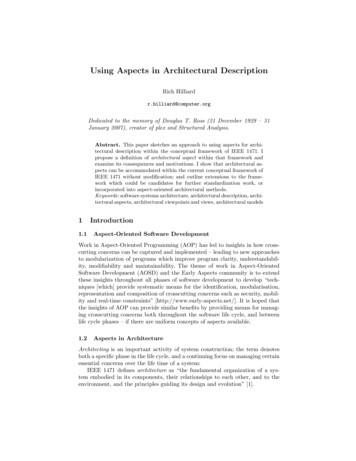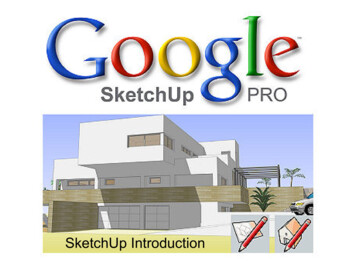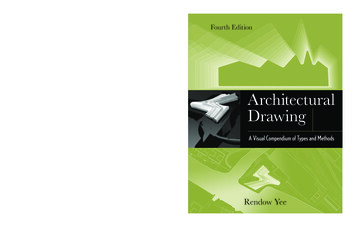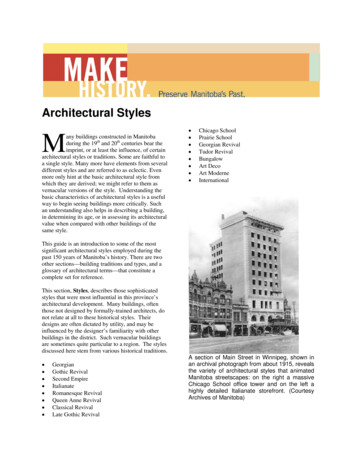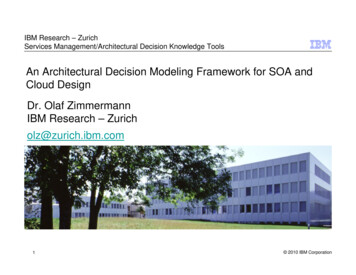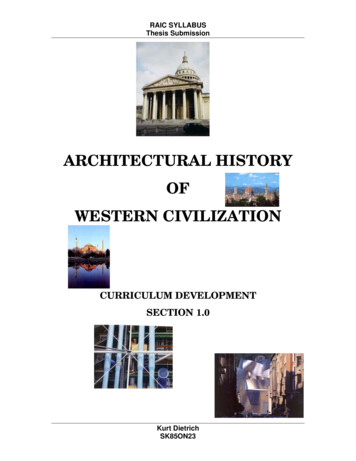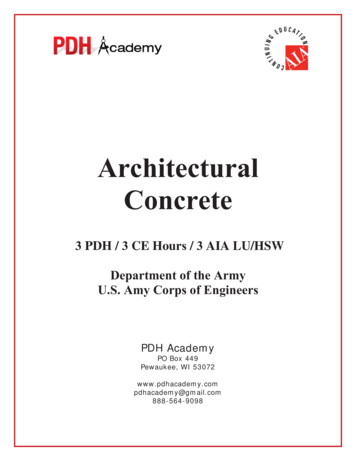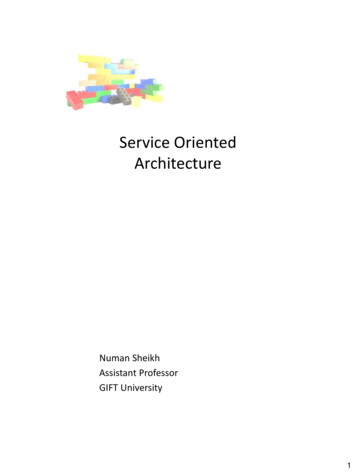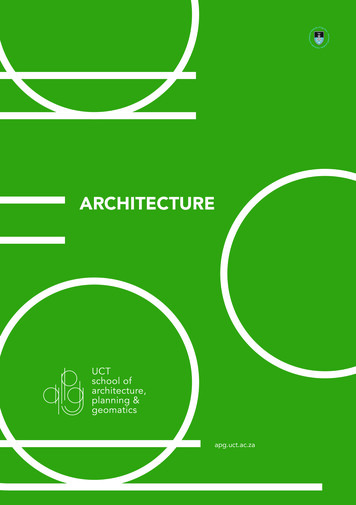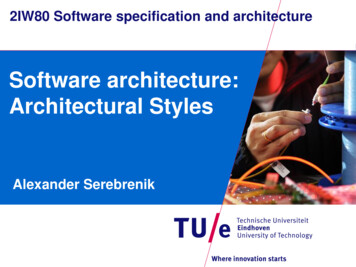
Transcription
2IW80 Software specification and architectureSoftware architecture:Architectural StylesAlexander Serebrenik
Before we start True or false? Domain-Specific Software Architecture is a part of aReference Architecture./ SET / W&I18-3-2014 PAGE 1
Before we start True or false? Domain-Specific Software Architecture is a part of aReference Architecture: FALSE Domain-Specific Software Architecture is broaderapplicable than a product line./ SET / W&I18-3-2014 PAGE 2
Before we start True or false? Domain-Specific Software Architecture is a part of aReference Architecture: FALSE Domain-Specific Software Architecture is broaderapplicable than a product line: TRUE Model-View-Controller is an examples of a DomainSpecific Software Architecture/ SET / W&I18-3-2014 PAGE 3
Before we start True or false? Domain-Specific Software Architecture is a part of aReference Architecture: FALSE Domain-Specific Software Architecture is broaderapplicable than a product line: TRUE Model-View-Controller is an examples of a DomainSpecific Software Architecture FALSE/ SET / W&I18-3-2014 PAGE 4
This week sourcesSlides byRudolf Mak Johan Lukkien
Recall: Architectural patterns vs. Architecturalstyles vs. Design patterns Architectural patterns define theimplementation strategies of thosecomponents and connectors (‘how?’) More domain specific Architectural styles define thecomponents and connectors(‘what?’) Less domain specific Good architecture makes use ofdesign patterns (on a more finegranular level) We’ll see examples later on Usually domain independent/ SET / W&I18-3-2014 PAGE 62IPC0
Architectural Styles An architectural style is a named collection of architecturaldesign decisions that are applicable in a given development context constrain architectural design decisions that are specificto a particular system within that context elicit beneficial qualities in each resulting system Reflect less domain specificity than architectural patterns Useful in determining everything from subroutine structure totop-level application structure Many styles exist and we will discuss them in detail in the nextlectureSoftware Architecture: Foundations, Theory, and Practice; Richard N. Taylor, Nenad Medvidovic, and Eric M. Dashofy; 2008 John Wiley & Sons, Inc. Reprinted with permission.
Benefits of Using Styles Reuse Design: Well-understood solutions applied to new problems Code: Shared implementations of invariant aspects of a style Understandability of system organization A phrase such as “client-server” conveys a lot of information Interoperability Supported by style standardization Style-specificity Analyses: enabled by the constrained design space Visualizations: depictions matching engineers’ mental modelsSoftware Architecture: Foundations, Theory, and Practice; Richard N. Taylor, Nenad Medvidovic, and Eric M. Dashofy; 2008 John Wiley & Sons, Inc. Reprinted with permission.
Basic Properties of Styles A vocabulary of design elements Component and connector types; data elements e.g., pipes, filters, objects, serversSoftware Architecture: Foundations, Theory, and Practice; Richard N. Taylor, Nenad Medvidovic, and Eric M. Dashofy; 2008 John Wiley & Sons, Inc. Reprinted with permission.
Recap: Connectors “Architectural styles define the components andconnectors” A software connector is an architectural building blocktasked with effecting and regulating interactions amongcomponents (Taylor, Medvidovic, Dashofy) / SET / W&IProcedure call connectorsShared memory connectorsMessage passing connectorsStreaming connectorsDistribution connectorsWrapper/adaptor connectors 18-3-2014 PAGE 10
Basic Properties of Styles A vocabulary of design elements Component and connector types; data elements e.g., pipes, filters, objects, servers A set of configuration rules Topological constraints that determine allowed compositionsof elements e.g., a component may be connected to at most two othercomponents A semantic interpretation Compositions of design elements have well-definedmeanings Possible analyses of systems built in a styleSoftware Architecture: Foundations, Theory, and Practice; Richard N. Taylor, Nenad Medvidovic, and Eric M. Dashofy; 2008 John Wiley & Sons, Inc. Reprinted with permission.
Some Common Styles Traditional, languageinfluenced styles Main program and subroutines Object-oriented Layered Virtual machines Client-server Data-flow styles Batch sequential Pipe and filter Shared memory Interpreter Interpreter Mobile code Implicit invocation Event-based Publish-subscribe Peer-to-peer “Derived” styles C2 CORBA Blackboard Rule basedSoftware Architecture: Foundations, Theory, and Practice; Richard N. Taylor, Nenad Medvidovic, and Eric M. Dashofy; 2008 John Wiley & Sons, Inc. Reprinted with permission.
Architecture Style Analysis / SET / W&ISummaryDesign elements (components, connectors, data)TopologyExamples of useAdvantages/disadvantagesRelation to programming languages/environments18-3-2014 PAGE 13
Main program and subroutines You should be familiar with this style from a basicprogramming courseMain program: displays greetings andinstructions enters a loop in which it callsthe three subroutines in turn./ SET / W&I18-3-2014 PAGE 14
Main program and subroutines: Style Analysis Summary: Decomposition based upon separation of functionalprocessing steps Design elements Components: main program and subroutines Connectors: function/procedure calls Data: Values passed in/out subroutines Topology Static organization is hierarchical Full structure: a directed graphSoftware Architecture: Foundations, Theory, and Practice; Richard N. Taylor, Nenad Medvidovic, and Eric M. Dashofy; 2008 John Wiley & Sons, Inc. Reprinted with permission.
Main program and subroutines: Style Analysis What are common examples of its use? Small programs, pedagogical uses What are the advantages of using the style? Modularity: subroutines can be replaced as long asinterface semantics are unaffected What are the disadvantages of using the style? Usually fails to scale Inadequate attention to data structures Effort to accommodate new requirements: unpredictable Relation to programming languages/environments Traditional programming languages: BASIC, Pascal, C Software Architecture: Foundations, Theory, and Practice; Richard N. Taylor, Nenad Medvidovic, and Eric M. Dashofy; 2008 John Wiley & Sons, Inc. Reprinted with permission.
Object-Oriented Lunar LanderYou should be familiar with thisstyle from an OO-programmingcourse.Identify similarities anddifferences between thestyles.
Object-Oriented Lunar LanderSimilarities:connectors(procedure calls) data (arguments)
Object-Oriented Lunar LanderDifferences: encapsulation(UI, SpaceCraft, Environment) Procedural: input & output areseparated OO: input & output are togetherSimilarities:connectors(procedure calls) data (arguments)
How would this looklike as a class diagram?GUIburnRate: doublegetBurnRate(): Craftusesaltitude: doublefuel: double1EnvironmentSimulationtime: intmoonGravity: doublevelocity: doublecalculateStatus(burnRate: double,s: SpaceCraft): SpaceCraftSpaceCraft(a:double,f:double, t:int, v: double)setAltitude(a: double)setFuel(f: double) getAltitude()getFuel() Software Architecture: Foundations, Theory, and Practice; Richard N. Taylor, Nenad Medvidovic, and Eric M. Dashofy; 2008 John Wiley & Sons, Inc. Reprinted with permission.
Object-Oriented Style: Style Analysis Summary: State strongly encapsulated. Internal representation ishidden from other objects Objects are responsible for their internal representationintegrity Design elements Components: objects (data and associated operations) Connectors: method invocations Data: arguments passed to methods Topology Can vary arbitrarily: data and interfaces can be sharedthrough inheritanceSoftware Architecture: Foundations, Theory, and Practice; Richard N. Taylor, Nenad Medvidovic, and Eric M. Dashofy; 2008 John Wiley & Sons, Inc. Reprinted with permission.
Object-Oriented Style: Style Analysis What are common examples of its use? pedagogy complex, dynamic data structures close correlation between physical world entities andentities in the program What are the advantages of using the style? Integrity: data is manipulated only by appropriate methods Abstraction: internals are hiddenSoftware Architecture: Foundations, Theory, and Practice; Richard N. Taylor, Nenad Medvidovic, and Eric M. Dashofy; 2008 John Wiley & Sons, Inc. Reprinted with permission.
Object-Oriented Style: Style Analysis What are the disadvantages of using the style? Not efficient enough for high performance computing (e.g.,scientific computing, data science) Distributed applications require extensive middleware toprovide access to remote objects In absence of additional structural principles unrestrictedOO can lead to highly complex applications Relation to programming languages/environments OO-languages: Java, C Software Architecture: Foundations, Theory, and Practice; Richard N. Taylor, Nenad Medvidovic, and Eric M. Dashofy; 2008 John Wiley & Sons, Inc. Reprinted with permission.
Layered Style Lunar Lander Basic idea: Each layer exposes an interface (API) tobe used by the layer above it Each layer acts as a Server: service provider to layer “above” Client: service consumer of the layer“below” Taylor et al call this style “virtualmachines” I do not like this name since these virtualmachines are not related to simulation orprogram execution as in “Java VirtualMachine”, Python, etc./ SET / W&I18-3-2014 PAGE 24
LayeringStrict LayeringNonstrict LayeringSoftware Architecture: Foundations, Theory, and Practice; Richard N. Taylor, Nenad Medvidovic, and Eric M. Dashofy; 2008 John Wiley & Sons, Inc. Reprinted with permission.
Layered Style: Style Analysis Summary: An ordered sequence of layers, each layer offers services(interfaces) that can be used by programs (components)residing with the layer(s) above it Design elements Components: layers, each layer usually several programs Connectors: typically procedure calls Data: parameters passed between layers Topology Linear (strict layering), acyclic (non-strict layering)Software Architecture: Foundations, Theory, and Practice; Richard N. Taylor, Nenad Medvidovic, and Eric M. Dashofy; 2008 John Wiley & Sons, Inc. Reprinted with permission.
Layered Style: Style Analysis What are common examples of its use? operating systems 2INC0 “Operating systems” SfS:Y3Q1 network and protocol stacks 2IC60 “Computer networks and security” SfS, brary/l-linux-kernel/Software Architecture: Foundations, Theory, and Practice; Richard N. Taylor, Nenad Medvidovic, and Eric M. Dashofy; 2008 John Wiley & Sons, Inc. Reprinted with permission.
Layered Style: Style Analysis What are the advantages of using the style? Clear dependence structure benefits evolution Lower layers are independent from the upper layers Upper layers can evolve independently from the lowerlayers as long as the interface semantics is unchanged Strict layering: limits propagation of change Reuse e.g., standardized layer interfaces for libraries/frameworks What are the disadvantages of using the style? Not universally applicable Performance (mostly for strict layering and many layers)Software Architecture: Foundations, Theory, and Practice; Richard N. Taylor, Nenad Medvidovic, and Eric M. Dashofy; 2008 John Wiley & Sons, Inc. Reprinted with permission.
Client-Server Style Similar to the layered style Differences Only two layers Client(s) Server Network-based connection Clients Thin – no processingbeyond UI Thick – otherwiseSoftware Architecture: Foundations, Theory, and Practice; Richard N. Taylor, Nenad Medvidovic, and Eric M. Dashofy; 2008 John Wiley & Sons, Inc. Reprinted with permission.
Client-Server Style: Style Analysis Summary: Client initiates communication by sending server a request. Server performs the requested action and replies. Design elements Components: client(s) and server Connectors: remote procedure call, network protocols Data: parameters and return values Topology Two-level, multiple clients making requests to server No client-client communicationSoftware Architecture: Foundations, Theory, and Practice; Richard N. Taylor, Nenad Medvidovic, and Eric M. Dashofy; 2008 John Wiley & Sons, Inc. Reprinted with permission.
Client-Server Style: Style Analysis What are common examples of its use? centralization of data is requiredserver: high-capacity machine (processing power)clients: simple UI tasksmany business applications 2IIC0 “Business Information Systems” SfS, WbS:Y3Q1Software Architecture: Foundations, Theory, and Practice; Richard N. Taylor, Nenad Medvidovic, and Eric M. Dashofy; 2008 John Wiley & Sons, Inc. Reprinted with permission.
Client-Server Style: Style Analysis What are common examples of its use? centralization of data is requiredserver: high-capacity machine (processing power)clients: simple UI tasksmany business applications 2IIC0 “Business Information Systems” SfS, WbS:Y3Q1 What are the advantages of using the style? Data centralization, powerful server serving many clients What are the disadvantages of using the style? Single point of failure Network bandwidth / amount of requestsSoftware Architecture: Foundations, Theory, and Practice; Richard N. Taylor, Nenad Medvidovic, and Eric M. Dashofy; 2008 John Wiley & Sons, Inc. Reprinted with permission.
Some Common Styles Traditional, languageinfluenced styles Main program and subroutines Object-oriented Layered (Virtual machines) Client-server Data-flow styles Batch sequential Pipe and filter Shared memory Interpreter Interpreter Mobile code Implicit invocation Event-based Publish-subscribe Peer-to-peer “Derived” styles C2 CORBA Blackboard Rule basedSoftware Architecture: Foundations, Theory, and Practice; Richard N. Taylor, Nenad Medvidovic, and Eric M. Dashofy; 2008 John Wiley & Sons, Inc. Reprinted with permission.
Batch Sequential Dataflow styles focus on how data moves betweenprocessing elements Batch-sequential “The Granddaddy of Styles” Separate programs areexecuted in order Aggregated data (on magnetictape) transferred by the userfrom one program to anotherSoftware Architecture: Foundations, Theory, and Practice; Richard N. Taylor, Nenad Medvidovic, and Eric M. Dashofy; 2008 John Wiley & Sons, Inc. Reprinted with permission.
Batch SequentialWhat about the Lunar Lander?/ SET / W&I18-3-2014 PAGE 35
Batch SequentialNot a recipe for asuccessful lunarmission!Software Architecture: Foundations, Theory, and Practice; Richard N. Taylor, Nenad Medvidovic, and Eric M. Dashofy; 2008 John Wiley & Sons, Inc. Reprinted with permission.
Batch Sequential: Style Analysis Summary: Separate programs executed one at a time, till completion Design elements Components: independent programs Connectors: “the human hand” carrying tapes between theprograms, a.k.a. “sneaker-net” Data: aggregated on tapes Topology Linear What are common examples of its use? Transaction processing in financial systemsSoftware Architecture: Foundations, Theory, and Practice; Richard N. Taylor, Nenad Medvidovic, and Eric M. Dashofy; 2008 John Wiley & Sons, Inc. Reprinted with permission.
Batch Sequential: Style Analysis What are the advantages of using the style? Simplicity Severable executions What are the disadvantages of using the style? No concurrency No interaction between componentsSoftware Architecture: Foundations, Theory, and Practice; Richard N. Taylor, Nenad Medvidovic, and Eric M. Dashofy; 2008 John Wiley & Sons, Inc. Reprinted with permission.
Pipe and Filter In Batch Sequential the next program waits till thepreceding one has finished processing data completely. What if the next program could process dataelements as soon as they become available? programs can operate concurrently speed up data is considered as streamsSoftware Architecture: Foundations, Theory, and Practice; Richard N. Taylor, Nenad Medvidovic, and Eric M. Dashofy; 2008 John Wiley & Sons, Inc. Reprinted with permission.
Pipe and Filter In Batch Sequential the next program waits till thepreceding one has finished processing data completely. What if the next program could process dataelements as soon as they become available? programs can operate concurrently speed up data is considered as streams Lunar LanderSoftware Architecture: Foundations, Theory, and Practice; Richard N. Taylor, Nenad Medvidovic, and Eric M. Dashofy; 2008 John Wiley & Sons, Inc. Reprinted with permission.
Pipe and Filter: Style Analysis Summary: Separate programs executed, potentially concurrently Design elements Components: independent programs, a.k.a. filters Connectors: routers of data streams (pipes), provided by anoperating system Variations Pipelines — linear sequences of filters Bounded pipes — limited amount of data on a pipe Typed pipes — data strongly typed Data: linear data streams, traditionally – textSoftware Architecture: Foundations, Theory, and Practice; Richard N. Taylor, Nenad Medvidovic, and Eric M. Dashofy; 2008 John Wiley & Sons, Inc. Reprinted with permission.
Pipe and Filter: Style Analysis Topology Usually linear pipelines, sometimes T-joins are possible What are common examples of its use?Have you seen this style before?Software Architecture: Foundations, Theory, and Practice; Richard N. Taylor, Nenad Medvidovic, and Eric M. Dashofy; 2008 John Wiley & Sons, Inc. Reprinted with permission.
Pipe and Filter: Style Analysis Topology Usually linear pipelines, sometimes T-joins are possible What are common examples of its use?Have you seen this style before? Unix: ls invoices grep –e “August” sort MS-DOS: dir findstr “Onder*”Software Architecture: Foundations, Theory, and Practice; Richard N. Taylor, Nenad Medvidovic, and Eric M. Dashofy; 2008 John Wiley & Sons, Inc. Reprinted with permission.
Pipe and Filter: Style Analysis Topology Usually linear pipelines, sometimes T-joins are possible What are common examples of its use?Have you seen this style before? Unix: ls invoices grep –e “August” sort MS-DOS: dir findstr “Onder*” Operating systems applications, shells Massive data processing applications Results of the processing are more important than theprocess itselfSoftware Architecture: Foundations, Theory, and Practice; Richard N. Taylor, Nenad Medvidovic, and Eric M. Dashofy; 2008 John Wiley & Sons, Inc. Reprinted with permission.
Pipes and Filters: Style Analysis What are the advantages of using the style? Simplicity Filters are independent New combinations can be easily constructed What are the disadvantages of using the style? Data structures to be exchanged should be relatively simple Usually text tables No interaction between components Relation to programming languages Unix shellsSoftware Architecture: Foundations, Theory, and Practice; Richard N. Taylor, Nenad Medvidovic, and Eric M. Dashofy; 2008 John Wiley & Sons, Inc. Reprinted with permission.
Blackboard Style Two kinds of components Central data structure — blackboard Components operating on the blackboard System control is entirely driven by the blackboard state Shared blackboard: problemdescription Multiple experts identify a (sub)problem they can solve,work on itpost the solution on the blackboardenable other experts to solve theirproblemhttps://www.google.nl/url?sa i&rct j&q &esrc s&source images&cd &cad rja&docid lcXWx6tOHnO2M&tbnid vKc0m3nirDdc6M:&ved 0CAUQ jRw&url %3Fref%3Dstream%26viewer id%3D0&ei HenjUrWLC4XGswaUh4GoAg&psig AFQjCNHy ehnRWgddxY0e9t-Uxvsrd8Hsg&ust 1390754460129161Software Architecture: Foundations, Theory, and Practice; Richard N. Taylor, Nenad Medvidovic, and Eric M. Dashofy; 2008 John Wiley & Sons, Inc. Reprinted with permission.
Blackboard Lunar LanderExperts performindependent tasksBlackboard maintainsthe game stateSoftware Architecture: Foundations, Theory, and Practice; Richard N. Taylor, Nenad Medvidovic, and Eric M. Dashofy; 2008 John Wiley & Sons, Inc. Reprinted with permission.
Blackboard: Style Analysis Summary: Separate programs communicate through the sharedrepository, known as the blackboard Design elements Components: shared blackboard independent programs, a.k.a. knowledge sources Connectors: depending on the context procedure calls, database queries, direct references Data: stored on the blackboard Topology: star, the blackboard as the central nodeSoftware Architecture: Foundations, Theory, and Practice; Richard N. Taylor, Nenad Medvidovic, and Eric M. Dashofy; 2008 John Wiley & Sons, Inc. Reprinted with permission.
Blackboard: Style Analysis What are common examples of its use? Heuristic problem solving in artificial intelligence Compiler!Syntactic analyzerLexical analyzerSemantic analyzerInternal representationsof the program(stored in blackboard)Bytecodegenerator/ SET / W&IOptimizer18-3-2014 PAGE 49
Blackboard: Style Analysis What are the advantages of using the style? Solution strategies should not be preplanned Data/problem determine the solutions! What are the disadvantages of using the style? Overhead when a straight-forward solution strategy is available interaction between “independent” programs need acomplex regulation data on the blackboard is a subject to frequent change(and requires propagation to all other components)Software Architecture: Foundations, Theory, and Practice; Richard N. Taylor, Nenad Medvidovic, and Eric M. Dashofy; 2008 John Wiley & Sons, Inc. Reprinted with permission.
Interpreter Style Compilers translate the (source) code to the executableform at once Interpreters translate the (source) code instructions oneby one and execute them To pass data from one instruction to the other we need tokeep the Interpreter state
Interpreter Style Compilers translate the (source) code to the executableform at once Interpreters translate the (source) code instructions oneby one and execute them To pass data from one instruction to the other we need tokeep the Interpreter state
Interpreter Style Compilers translate the (source) code to the executableform at once Interpreters translate the (source) code instructions oneby one and execute them To pass data from one instruction to the other we need tokeep the Interpreter state
Interpreter Style Compilers translate the (source) code to the executableform at once Interpreters translate the (source) code instructions oneby one and execute them To pass data from one instruction to the other we need tokeep the Interpreter state
How is this related to architecture?Interpreter Lunar Lander User commands constitute alanguage“Burn 50” – set the burnrate to 50“Check status” Example of a domain-specificlanguage (DSL) Do you recall Domain-Specific SoftwareArchitectures? Active research topic in Eindhoven 2IS15 Generic language technology This language is being interpreted bythe rest of the implementationSoftware Architecture: Foundations, Theory, and Practice; Richard N. Taylor, Nenad Medvidovic, and Eric M. Dashofy; 2008 John Wiley & Sons, Inc. Reprinted with permission.
Interpreter Style: Style Analysis Summary: Interpreter parses and executes input commands, updatingthe state maintained by the interpreter Design elements Components: command interpreter program/interpreter state user interface. Connectors: typically very closely bound with directprocedure calls and shared state. Data: commandsSoftware Architecture: Foundations, Theory, and Practice; Richard N. Taylor, Nenad Medvidovic, and Eric M. Dashofy; 2008 John Wiley & Sons, Inc. Reprinted with permission.
Interpreter Style: Style Analysis Topology Tightly-coupled three-tier, state can be separate What are common examples of its use? Great when the user should be able to program herself e.g., Excel formulas domain-specific languages become more and morepopular Not all of them are interpreted, but many of them are / SET / W&I18-3-2014 PAGE 57
Interpreter Style: Style Analysis What are the advantages of using the style? Highly dynamic behavior possible, where the set ofcommands is dynamically modified. System architecture may remain constant while newcapabilities are created based upon existing primitives. What are the disadvantages of using the style? Performance it takes longer to execute the interpreted code but many optimizations might be possible Memory management when multiple interpreters are invoked simultaneously/ SET / W&I18-3-2014 PAGE 58Software Architecture: Foundations, Theory, and Practice; Richard N. Taylor, Nenad Medvidovic, and Eric M. Dashofy; 2008 John Wiley & Sons, Inc. Reprinted with permission.
Mobile Code Style Sometimes interpretation cannot be performed locally Code-on-demand Client has resources and processing power Server has code to be executed Client requests the code, obtains it and runs it locallyClientServerrequest webpagereturn JavaScript coderun in thebrowser/ SET / W&I18-3-2014 PAGE 59JavaScriptcode
Mobile Code Style Sometimes interpretation cannot be performed locally Code-on-demand Remote execution/evaluation client has code but does not have resources to execute it software resources (e.g., interpreter) or hardware resources (e.g., processing power) 2IN28 Grid and cloud computingClientServer (grid)coderesults/ SET / W&I18-3-2014 PAGE 60run
Mobile Code Style Sometimes interpretation cannot be performed locally Code-on-demand Remote execution/evaluation Mobile agent initiator has code and some resources but not all can autonomously decide to migrate to a different node toobtain additional resourceshttp://maf.sourceforge.net// SET / W&I18-3-2014 PAGE 61
Mobile Code Style: Major challenge – Security Code being executed might be malicious! privacy invasion denial of service Solutions: 2IC60 Computer networksand security – Y2Q4 Master track IST Sandboxing Mobile code runs only in a restricted environment,“sandbox”, and does not have access to vital parts of thesystem Signing Only mobile code signed by a trusted party can be executed Responsibility: execution dock handling receipt and executionof code and state/ SET / W&I18-3-2014 PAGE 62
Mobile Code Style: Style Analysis Summary: Code moves to be interpreted on another host Variants: code on demand, remote execution, mobile agent Design elements Components: code interpreter, execution dock Connectors: network protocols code/data packaging for transmission Data: code, program state, data for the code Topology: networkSoftware Architecture: Foundations, Theory, and Practice; Richard N. Taylor, Nenad Medvidovic, and Eric M. Dashofy; 2008 John Wiley & Sons, Inc. Reprinted with permission.
Mobile Code Style: Style Analysis What are common examples of its use? processing large amounts of distributed data dynamic behavior / customization What are the advantages of using the style? dynamic adaptability performance (resources) What are the disadvantages of using the style? security challenges network/transmission costs/ SET / W&I18-3-2014 PAGE 64Software Architecture: Foundations, Theory, and Practice; Richard N. Taylor, Nenad Medvidovic, and Eric M. Dashofy; 2008 John Wiley & Sons, Inc. Reprinted with permission.
Some Common Styles Traditional, languageinfluenced styles Main program and subroutines Object-oriented Layered (Virtual machines) Client-server Data-flow styles Batch sequential Pipe and filter Shared memory Interpreter Interpreter Mobile code Implicit invocation Event-based Publish-subscribe Peer-to-peer “Derived” styles C2 CORBA Blackboard Rule basedSoftware Architecture: Foundations, Theory, and Practice; Richard N. Taylor, Nenad Medvidovic, and Eric M. Dashofy; 2008 John Wiley & Sons, Inc. Reprinted with permission.
Implicit Invocation Styles Basic idea Event announcement instead of method invocation “Listeners” register interest in and associate methods withevents System invokes all registered methods implicitly Style invariants “Announcers” are unaware of their events’ effects No assumption about processing in response to eventsSoftware Architecture: Foundations, Theory, and Practice; Richard N. Taylor, Nenad Medvidovic, and Eric M. Dashofy; 2008 John Wiley & Sons, Inc. Reprinted with permission.
Publish-Subscribe Subscribers register/deregister to receive specificmessages or specific content. Publishers broadcast messages to subscribers. Analogy: newspaper subscription Subscriber chooses the newspaper Publisher delivers only tosubscribers Ergo, publisher has to maintain alist of bscription-donate-it/ Sometimes we’ll need proxies tomanage distribution./ SET / W&I18-3-2014 PAGE 67
Publish-Subscriber Lunar LanderPlayers68Software Architecture: Foundations, Theory, and Practice; Richard N. Taylor, Nenad Medvidovic, and Eric M. Dashofy; 2008 John Wiley & Sons, Inc. Reprinted with permission.
Publish-Subscribe Style: Style Analysis Summary: Subscribers register/deregister to receive specificmessages or specific content. Publishers broadcast messages to subscriberssynchronously or asynchronously. Design elements Components: publishers, subscribers Connectors: procedure calls/network protocols Data: subscriptions, notifications, published i
Domain-Specific Software Architecture is a part of a Reference Architecture: FALSE Domain-Specific Software Architecture is broader applicable than a product line: TRUE Model-View-Controller is an examples of
